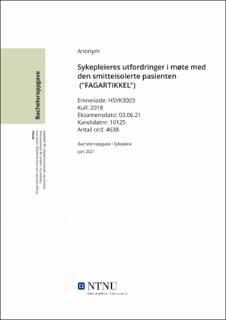| dc.contributor.advisor | Haugan, Siri | |
| dc.contributor.author | Maske, Maria | |
| dc.date.accessioned | 2021-09-25T16:23:52Z | |
| dc.date.available | 2021-09-25T16:23:52Z | |
| dc.date.issued | 2021 | |
| dc.identifier | no.ntnu:inspera:81643445:39053137 | |
| dc.identifier.uri | https://hdl.handle.net/11250/2782911 | |
| dc.description.abstract | Introduksjon
Smitteisolering i sykehus er viktig for å forebygge og begrense smittespredning. Samtidig kan
isolering føre til reaksjoner hos den isolerte pasienten, og skape utfordringer for sykepleiere.
Hensikten med studien er å undersøke hvilke utfordringer sykepleiere erfarer i møte med den
smitteisolerte pasienten på sengepost.
Metode
Studiens datainnsamling er gjennomført med kvalitative forskningsintervju av tre sykepleiere
på en somatisk sengepost ved et sykehus i Midt-Norge. Intervjuene er skrevet ned og
analysert, og funnene er systematisert etter relevans til studien. I tillegg har jeg studert
forskningslitteratur om temaet og sammenholdt funn der med min studie.
Resultat
Resultatene er systematisert og delt inn i hovedkategorier og underkategorier. Basert på
utsagnene til informantene erfarer de flere utfordringer i møte med den smitteisolerte
pasienten. Smittevernstiltak, tidsknapphet og barrierer i kommunikasjon er eksempler på
utfordringer de opplever. Gjennomgående i intervjuene var at samtlige informanter opplevde
travelhet som den største utfordringen.
Konklusjon
Sett i lys av hvor viktig global smittebegrensning i helsetjenesten er, og kommer til å være i
fremtiden er funnene i denne studien relevant. Studiens funn viser at travelhet blir ansett som
den største utfordringen i møte med den smitteisolerte pasienten. Mangelen på tid kan
påvirke hvor ofte sykepleieren er innom pasienten, og gå på bekostning av sykepleierens
mulighet til å observere endring i pasientens tilstand. Smittevernsutstyr oppleves også av og
til som en fysisk barriere i kommunikasjonen mellom sykepleier og pasient, spesielt i møte
med enkelte sårbare pasientgrupper. | |
| dc.description.abstract | Introduction
Source isolation in hospitals is important in order to preventing and limiting the spread of
infection. However, isolation can also cause reactions from the isolated patient, and create
challenges for nurses. The purpose of the study is to investigate the challenges nurses
experience when meeting the patients in source isolation.
Method
Data collection was conducted through qualitative research interviews with three nurses from a
somatic ward at a hospital in Central Norway. The interviews have been written down and
analyzed, and the findings have been systematized based on the relevance to the study. In
addition, I have studied research literature on the topic and compared findings there with my
results.
Results
The results show that nurses experience several challenges when meeting the patient in source
isolation. Based on the statements of the informants in the study, infection control measures,
lack of time and barriers in communication are some of the challenges they experience.
Throughout the interviews, a lack of time was identified as the greatest challenge.
Conclusion
Given the importance of global infection control in the health service, and how important it will
be in the future, the findings in this study are relevant. The study’s findings show that busyness
is considered the biggest challenge in meeting the patient in source isolation. The lack of time
can affect how often the nurse visits the patient, and may be at the expense of the nurse’s ability
to observe changes in the patient’s condition. Personal protective equipment is also sometimes
perceived as a physical barrier in the communication between nurse and patient, especially in
encounters with certain vulnerable groups. | |
| dc.language | nob | |
| dc.publisher | NTNU | |
| dc.title | Sykepleieres utfordringer i møte med den smitteisolerte pasient | |
| dc.type | Bachelor thesis | |
